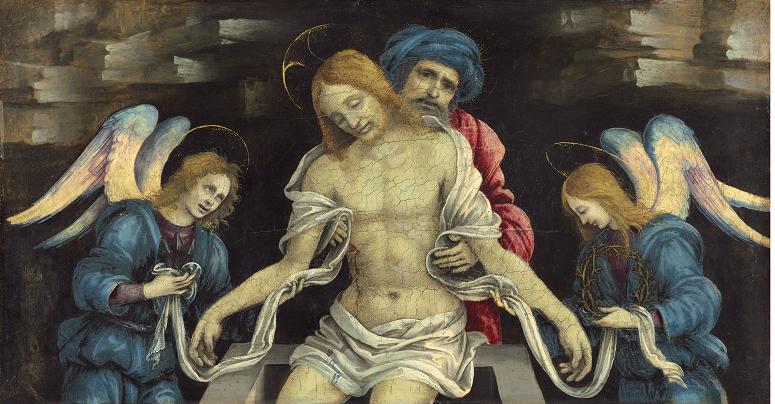Pieta (c1499). Marble. 175. The Pietà is a work of Renaissance sculpture by Michelangelo Buonarroti, housed in St. Peter's Basilica, Vatican City. It is the first of a number of works of the same theme by the artist. The statue was commissioned for the French Cardinal Jean de Bilhères, who was a representative in Rome. The sculpture, in Carrara marble, was made for the cardinal's funeral monument, but was moved to its current location, the first chapel on the right as one enters the basilica, in the 18th century. It is the only piece Michelangelo ever signed. This famous work of art depicts the body of Jesus on the lap of his mother Mary after the Crucifixion. The theme is of Northern origin. Michelangelo's interpretation of the Pietà is unprecedented in Italian sculpture. It is an important work as it balances the Renaissance ideals of classical beauty with naturalism. In 2019, a small terracotta figure identified as a model for the final sculpture was displayed in Paris. he structure is pyramidal, and the vertex coincides with Mary's head. The statue widens progressively down the drapery of Mary's dress, to the base, the rock of Golgotha. The figures are quite out of proportion, owing to the difficulty of depicting a fully-grown man cradled full-length in a woman's lap. Much of Mary's body is concealed by her monumental drapery, and the relationship of the figures appears quite natural. Michelangelo's interpretation of the Pietà was far different from those previously created by other artists, as he sculpted a young and beautiful Mary rather than an older woman around 50 years of age. The marks of the Crucifixion are limited to very small nail marks and an indication of the wound in Jesus' side. Christ's face does not reveal signs of the Passion. Michelangelo did not want his version of the Pietà to represent death, but rather to show the religious vision of abandonment and a serene face of the Son, thus the representation of the communion between man and God by the sanctification through Christ. The Madonna is represented as being very young for the mother of an approximately 33-year-old son, which is not uncommon in depictions of her at the time of the Passion of Christ. Various explanations have been suggested for this. One is that her youth symbolizes her incorruptible purity, as Michelangelo himself said to his biographer and fellow sculptor Ascanio Condivi. Do you not know that chaste women stay fresh much more than those who are not chaste? How much more in the case of the Virgin, who had never experienced the least lascivious desire that might change her body? Another explanation suggests that Michelangelo's treatment of the subject was influenced by his passion for Dante's Divina Commedia: so well-acquainted was he with the work that when he went to Bologna, he paid for hospitality by reciting verses from it. In Paradiso, Saint Bernard, in a prayer for the Virgin Mary, says Vergine madre, figlia del tuo figlio. This is said because, since Christ is one of the three figures of Trinity, Mary would be his daughter, but it is also she who bore him. Following completion, the Pietà's first home was the Chapel of Santa Petronilla, a Roman mausoleum near the south transept of St. Peter's, which the Cardinal chose as his funerary chapel. The chapel was later demolished by Bramante during his rebuilding of the basilica. According to Giorgio Vasari, shortly after the installation of his Pietà, Michelangelo overheard someone remark that it was the work of another sculptor, Cristoforo Solari, whereupon Michelangelo signed the sculpture. Michelangelo carved MICHAELAGELUS BONAROTUS FLORENTIN FACIEBA (Michelangelo Buonarroti, Florentine, made on the sash running across Mary's chest. The signature echoes one used by the ancient Greek artists, Apelles and Polykleitos. It was the only work he ever signed. Vasari also reports the anecdote that Michelangelo later regretted his outburst of pride and swore never to sign another work of his hands. In 1964, the Pietà was lent by the Vatican to the 1964–65 New York World's Fair to be installed in the Vatican pavilion. Francis Cardinal Spellman, who had requested the statue from Pope John XXIII, appointed Edward M. Kinney, Director of Purchasing and Shipping of Catholic Relief Services - USCC, to head up the Vatican Transport Teams. People stood in line for hours to catch a glimpse from a conveyor belt moving past the sculpture. It was returned to the Vatican after the fair.
more...






